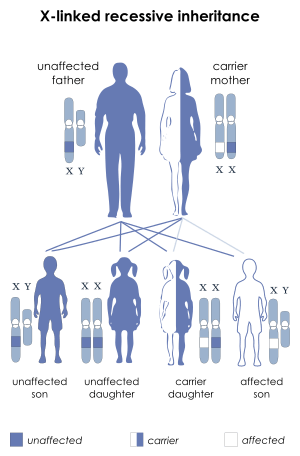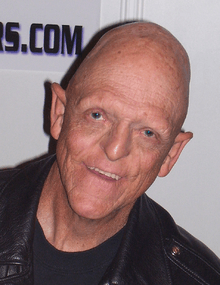Hypohidrotic ectodermal dysplasia
Hypohidrotic ectodermal dysplasia is one of about 150 types of ectodermal dysplasia in humans. Before birth, these disorders result in the abnormal development of structures including the skin, hair, nails, teeth, and sweat glands.[2]:515–517
| Hypohidrotic ectodermal dysplasia | |
|---|---|
| Other names | Anhidrotic ectodermal dysplasia, Christ-Siemens-Touraine syndrome[1]:570 |
 | |
| This condition is inherited in an X-linked recessive manner. | |
| Specialty | Medical genetics |
Presentation

Most people with hypohidrotic ectodermal dysplasia have a reduced ability to sweat (hypohidrosis) because they have fewer sweat glands than normal or their sweat glands do not function properly. Sweating is a major way that the body controls its temperature; as sweat evaporates from the skin, it cools the body. An inability to sweat can lead to a dangerously high body temperature (hyperthermia) particularly in hot weather. In some cases, hyperthermia can cause life-threatening medical problems.
Affected individuals tend to have sparse scalp and body hair (hypotrichosis). The hair is often light-coloured, brittle, and slow-growing. This condition is also characterized by absent teeth (hypodontia) or teeth that are malformed. The teeth that are present are frequently small and pointed.
Hypohidrotic ectodermal dysplasia is associated with distinctive facial features including a prominent forehead, thick lips, and a flattened bridge of the nose. Additional features of this condition include thin, wrinkled, and dark-colored skin around the eyes; chronic skin problems such as eczema; and a bad-smelling discharge from the nose (ozena).
Hypohidrotic ectodermal dysplasia is the most common form of ectodermal dysplasia in humans. It is estimated to affect at least 1 in 17,000 people worldwide.
Genetics
Mutations in the EDA, EDAR, and EDARADD genes cause hypohidrotic ectodermal dysplasia. The EDA, EDAR, and EDARADD genes provide instructions for making proteins that work together during embryonic development. These proteins form part of a signaling pathway that is critical for the interaction between two cell layers, the ectoderm and the mesoderm. In the early embryo, these cell layers form the basis for many of the body's organs and tissues. Ectoderm-mesoderm interactions are essential for the formation of several structures that arise from the ectoderm, including the skin, hair, nails, teeth, and sweat glands.
Hypohidrotic ectodermal dysplasia has several different inheritance patterns.
EDA (X-linked)
Most cases are caused by mutations in the EDA gene, which are inherited in an X-linked recessive pattern, called x-linked hypohidrotic ectodermal dysplasia (XLHED). A condition is considered X-linked if the mutated gene that causes the disorder is located on the X chromosome, one of the two sex chromosomes. In males (who have only one X chromosome), one altered copy of the gene in each cell is sufficient to cause the condition. In females (who have two X chromosomes), a mutation must be present in both copies of the gene to cause the disorder. Males are affected by X-linked recessive disorders much more frequently than females. A striking characteristic of X-linked inheritance is that fathers cannot pass X-linked traits to their sons.
In X-linked recessive inheritance, a female with one altered copy of the gene in each cell is called a carrier. Since females operate on only one of their two X chromosomes (X inactivation) a female carrier may or may not manifest symptoms of the disease. If a female carrier is operating on her normal X she will not show symptoms. If a female is operating on her carrier X she will show symptoms. In about 70 percent of cases, carriers of hypohidrotic ectodermal dysplasia experience some features of the condition. These signs and symptoms are usually mild and include a few missing or abnormal teeth, sparse hair, and some problems with sweat gland function. Some carriers, however, have more severe features of this disorder.
Treatments
In January 2013, Edimer Pharmaceuticals a biotechnology company based in Cambridge, MA, USA initiated a Phase I, open-label, safety and pharmacokinetic clinical study of EDI200, a drug aimed at the treatment of XLHED.[3] During development in mice and dogs EDI200 has been shown to substitute for the altered or missing protein resulting from the EDA mutation which causes XLHED. A second trial in newborn infants with XLHED tested the synthetic protein in 10 boys between 2013-16 at 6 sites (3 in the US and 3 in Europe)[4]. While there were some improvements overall the treated group "didn’t see significant changes in sweat gland function and other early markers of biologic activity."[5]
Following the first Edimer trials, a German physician, Dr. Holm Schneider, injected EDI200 via amniocentesis with better development of tooth buds and sweat glands than in the post birth trial and persistent sweating ability in all three treated boys[6] [7].
EDAR or EDARADD (autosomal)
Less commonly, hypohidrotic ectodermal dysplasia results from mutations in the EDAR or EDARADD gene. EDAR mutations can have an autosomal dominant or autosomal recessive pattern of inheritance, and EDARADD mutations have an autosomal recessive pattern of inheritance. Autosomal dominant inheritance means one copy of the altered gene in each cell is sufficient to cause the disorder. Autosomal recessive inheritance means two copies of the gene in each cell are altered. Most often, the parents of an individual with an autosomal recessive disorder are carriers of one copy of the altered gene but do not show signs and symptoms of the disorder.
Notable individuals
- Michael Berryman, Saturn Award-nominated character actor
Alternate name
The eponym Christ-Siemens-Touraine syndrome was named after its discoverers: Josef Christ (1871–1948), a German dentist and physician from Wiesbaden, who was the first physician to identify the condition, Hermann Werner Siemens (1891–1969), a pioneering German dermatologist from Charlottenburg, who clearly identified its pathological characteristics in the early 1930s, and Albert Touraine (1883–1961), a French dermatologist who likewise noted and identified additional characteristics of the disease in the late 1930s.
See also
- Hermann Werner Siemens
- List of cutaneous conditions
- Albert Touraine
- List of radiographic findings associated with cutaneous conditions
- List of dental abnormalities associated with cutaneous conditions
References
- James, William; Berger, Timothy; Elston, Dirk (2005). Andrews' Diseases of the Skin: Clinical Dermatology. (10th ed.). Saunders. ISBN 0-7216-2921-0.
- Freedberg, et al. (2003). Fitzpatrick's Dermatology in General Medicine. (6th ed.). McGraw-Hill. ISBN 0-07-138076-0.
- "Phase 2 Study to Evaluate Safety, Pharmacokinetics, Immunogenicity and Pharmacodynamics/Efficacy of EDI200 in Male Infants With X-Linked Hypohidrotic Ectodermal Dysplasia (XLHED) - Full Text View - ClinicalTrials.gov". Retrieved 2018-09-19.
- "Phase 2 Study to Evaluate Safety, Pharmacokinetics, Immunogenicity and Pharmacodynamics/Efficacy of EDI200 in Male Infants With X-Linked Hypohidrotic Ectodermal Dysplasia (XLHED) - Full Text View - ClinicalTrials.gov". Retrieved 2018-04-29.
- "X-Linked Hypohidrotic Ectodermal Dysplasia | National Foundation for Ectodermal Dysplasias". National Foundation for Ectodermal Dysplasias. Retrieved 2018-04-29.
- "Babies With XLHED Treated In Utero | National Foundation for Ectodermal Dysplasias". National Foundation for Ectodermal Dysplasias. 2016-12-07. Retrieved 2018-04-29.
- Schneider, Holm; Faschingbauer, Florian; Schuepbach-Mallepell, Sonia; Körber, Iris; Wohlfart, Sigrun; Dick, Angela; Wahlbuhl, Mandy; Kowalczyk-Quintas, Christine; Vigolo, Michele (2018-04-26). "Prenatal Correction of X-Linked Hypohidrotic Ectodermal Dysplasia". New England Journal of Medicine. 378 (17): 1604–1610. doi:10.1056/NEJMoa1714322. ISSN 0028-4793. PMID 29694819.
External links
| Classification | |
|---|---|
| External resources |
|
- GeneReview/NIH/UW entry on Hypohidrotic Ectodermal Dysplasia
- Hypohidrotic ectodermal dysplasia at NLM Genetics Home Reference